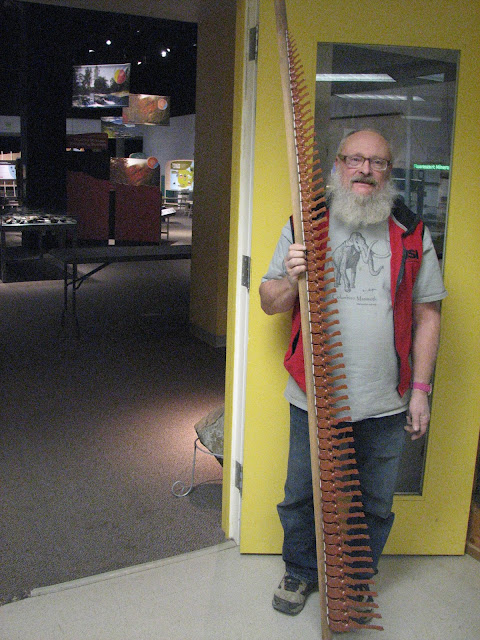I've been getting ready for a big display about Bernie at the "Regional Show" here at the Washington county fairgrounds this weekend. This show consists of displays from 5 local clubs - lapidary, rock and fossils. We have this show every year at the Washington county fairgrounds in October. The NARG fossil club is one of the larger clubs exhibiting.
This year one of the advertised headlines for the show is Bernie "Older than Dinosaurs!". So I've been working to put together a good presentations. I'll have two display cases as well as bringing my 3D printer (and running it). I may also bring my 3D scanner as well, though we may be tight for desk space for it.
So for a good display I've been printing bones - Lots 'O Bones - though I haven't printed out all the bones we have prepared. For the bones that are centerline (brain cases, vertebra) I only have one of each. For the rest I've been printing out mirror images as well as the originals so as to recreate a full animal. Here is what I have to-date:
We have a full skull in white: the original half-skull below it. Skull roof pieces from two other skulls with their mirror images. Two premaxillas, one with a mirror image. Three braincases, and parts of a 4th and 5th. Some internal skull bones - probably related to the palate. Two humeri - we have other limb bones but I haven't printed them yet. A start of the tail - thirteen bones out of a total of 65 (see why I picked 65 later). These vertebra are 1,5,10 etc - the graduations between the adjacent vertebra are finer. And a 1/2 and 1/4 scale mason's hammer!
As you see, these bones are quite glossy. They are all printed in ABS and have been smoothed with hot acetone vapor. It is harder to print large pieces with ABS but the smoothing process makes it worthwhile.
So here is the process I have followed to print out the graduated series of tailbones for a full size reproduction.
1) Have a good bone to copy. In real life, a body vert is not like a neck vert is not like a tail vert. However, I have a really good centrum + neural process combination that I wanted to copy so I used that. Here's the picture taken during scanning:
It is the best combo found to-date.
2) Have a good know specimen to copy and get dimensions from. Since we don't have an articulated specimen of Bernie, I have chosen to get dimensions from a wonderful specimen of Midentosaurus Brevis from China. This animal is about the same size as Bernie, the same age, and is wonderfully complete. Here is the reference article data:
Look at how complete this specimen is! This thing is 12 feet long!
Best of all, they have closeups of the tail so I can get accurate dimensions of all the tail verts! And they all have neural processes (probably to make a flattened tail to swim with) so my choice of a vert+centrum can be partially justified. Wait until I get the chevrons (the little Y-shaped bones under the verts) printed too. This animal had 13 neck verts, 25 body verts, 2 sacral verts and 65 tail verts (that's where the 65 comes from).
3) I took measurements of the length and diameter of the verts (minus the neural processes) and put them in a spreadsheet. I did a curve-fit on the data, and projected out the dimensions of each vert as a percent of the largest (number 1). My inner engineer is showing.
4) A series of bones is then prepared in the Slic3r software. I can import the scanned bone:
Set it upright and duplicate it. My computer can only handle 6 copies at once, so I'll end up printing variations of this about 11 times.
Now, each individual vert can be scaled according to the dimensions on the spreadsheet to gradually decrease in length and width as we go back the tail. The two dimensions do not scale at the same rate - the verts get smaller in diameter faster than they get shorter, so the verts become skinnier and skinnier.
5) Last of all, the bones are printed, cleaned up and vapor-smoothed. I've printed up 13 but some will have to be done again as the initial scaling was incorrect. Overall they will be a tail about 50 inches long!
This goes to show some of the real benefits of 3D scanning and printing instead of moulding and casting. Scaling objects and making mirror images is really easy using 3D digital techniques.
Sincerely, Greg Carr

























































